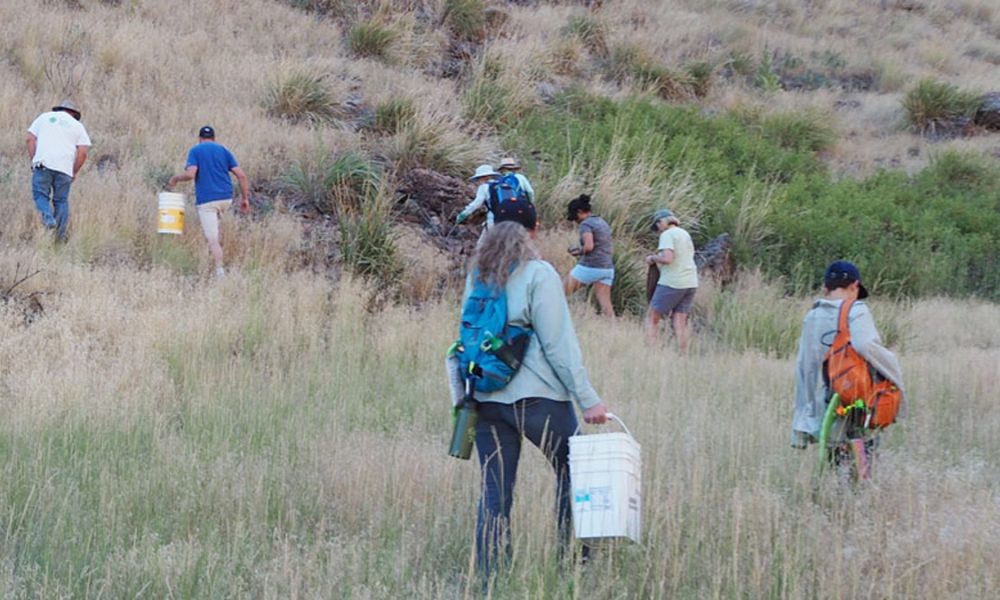Participants in a Saturday morning tour to find Thundereggs search a section of land in a remote part of the county. Nyssa’s Thunderegg Days celebration has evolved over the year but the mythical rocks remain at the heart of the festival. (The Enterprise/Max Egener).
NYSSA – The annual Thunderegg Days in Nyssa is an opportunity for people from across the region to gather in the thunderegg capital of the world to celebrate Oregon’s state rock.
Starting last Thursday morning and ending on Saturday night, people enjoyed live music, a lawnmower race, a fun run, fireworks, and vendors serving barbecue, sushi, fried foods and sandwiches.
People shopped at booths selling the crystal-filled geologic wonders that are thundereggs.
But what are thundereggs exactly? And how does one find them? Thunderegg hunters – also known as “rock hounds” – learned the answers to those questions during the festival’s three rock hound tours.
At 7:15 a.m. Saturday, a caravan of 11 cars barreled out of the Nyssa Middle School parking lot down Oregon Highway 201 toward Succor Creek State Natural Area, where they spent the morning picking through a rocky hillside for thundereggs.
“Mother Nature gave us the perfect conditions to find thundereggs here,” tour guide and local archeologist Bill Nance told the other rock hounds with buckets and pickaxes in hand.
Thundereggs were a part of legends for Native American tribes in the area, Nance said.
“The legend says that two thunder birds got into an argument,” he said. They began picking up stones from Mt. Hood and Mt. Jefferson and hurling them at each other, scattering the thunder-touched stones throughout the state.
Nance was more comfortable talking about the scientific origins of thundereggs. He explained how during the last 16 million years, following a massive volcanic eruption in what is now Yellowstone National Park, the southeast region of Oregon experienced lava flows perfect for the formation of thundereggs.
Thundereggs are formed when lava beneath the earth’s crust shoots to the surface in a dramatic change in pressure. That pressure change creates gas bubbles in the lava, and when the lava hardens, those round pockets of gas remain.
“It’s like when you uncork a bottle of champagne,” Nance said.
All the gases that were previously under pressure in the liquid come together and form thousands of little bubbles. Over millions of years, groundwater passing through the bubbles in the rock deposits silica, which accumulates and makes the brilliant, multi-colored crystal structures people find on the inside of thundereggs.
As the rocks erode, thundereggs ranging in size from a marble to a grapefruit – as one rock hound on the tour discovered – fall away to be discovered by rock enthusiasts. The lack of vegetation in the region also helps people find them.
The rocks are so inspiring that in 1965 the Oregon Legislature declared the thunderegg Oregon’s state rock. With events such as the Thunderegg Days, a thunderegg economy has been created. Hobbyists from all over the region come to the areas outside Nyssa to go rock hounding.
Sue and Gary Cook, two long-time rock hounds, drove from Portland to attend the festival for the first time this year. They went on Nance’s tours Friday and Saturday.
“It relaxes me,” Sue Cook said. “I need to get outside because I have a desk job at home.”
She directs a hospital oncology program in Portland and her husband works for a contractor on Portland’s light rail system.
But rock hounding is more than just a weekend outdoor hobby for the couple. Her father was an avid rock hounder.
“It was our time together,” Sue said. She has carried on his favorite outdoor activity and passed it on to her husband. Now, they enjoy rock hounding together.
Nance said he conducts the tours because it’s a family friendly activity and “it’s a great way to spend time with people and learn about the history of this area.”
Reporter Max Egener: [email protected] or 541-473-3377.





